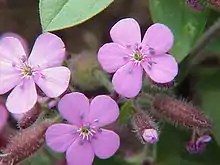Saponaria
Saponaria is a genus of flowering plants in the family Caryophyllaceae, native to Asia and Europe, and are commonly known as soapworts.[1] They are herbaceous perennials and annuals, some with woody bases. The flowers are abundant, five-petalled and usually in shades of pink[2] or white.[1] The genus is closely related to the genus Silene, being distinguished from these by having only two (not three or five) styles in the flower.[2] It is also related to Gypsophila, but its calyx is cylindrical rather than bell-shaped.[3]
| Saponaria | |
|---|---|
 | |
| Saponaria ocymoides | |
| Scientific classification | |
| Kingdom: | Plantae |
| Clade: | Tracheophytes |
| Clade: | Angiosperms |
| Clade: | Eudicots |
| Order: | Caryophyllales |
| Family: | Caryophyllaceae |
| Genus: | Saponaria L. |
| Species | |
|
30-40, see text | |
The most familiar species might be common soapwort (S. officinalis), which is native to Eurasia but is known in much of the world as an introduced species, often a weed, and sometimes a cultivated ornamental plant.[1] The genus name Saponaria derives from the Latin sapo ("soap") and -aria ("pertaining to"),[1] and at least one species, S. officinalis, has been used to make soap.[4] It contains saponins, and a liquid soap can be produced by soaking the leaves in water.[1] This soap is still used to clean delicate antique tapestries.[5]
Saponaria species are eaten by the larvae of some butterflies and moths, including the Lychnis and Coleophora saponariella, which is exclusive to the genus.
Diversity
There are thirty[3][6] to forty[1][7][8] species in the genus.
Species include:[9]
- Saponaria bargyliana[10]
- Saponaria bellidifolia
- Saponaria caespitosa
- Saponaria calabrica – Adriatic soapwort
- Saponaria jagelii
- Saponaria karapinarensis[11]
- Saponaria kotschyi[12]
- Saponaria lutea
- Saponaria ocymoides – rock soapwort, tumbling-Ted
- Saponaria officinalis – bouncingbet, sweet Betty
- Saponaria pamphylica
- Saponaria pumila[13]
- Saponaria pumilio – pygmy pink
- Saponaria sicula
- Saponaria suffruticosa[14]
References
- Thieret, John W.; Rabeler, Richard K. (2005). "Saponaria". In Flora of North America Editorial Committee (ed.). Flora of North America North of Mexico (FNA). Vol. 5. New York and Oxford: Oxford University Press – via eFloras.org, Missouri Botanical Garden, St. Louis, MO & Harvard University Herbaria, Cambridge, MA.
- RHS A–Z Encyclopedia of Garden Plants. United Kingdom: Dorling Kindersley. 2008. ISBN 978-1405332965.
- Ghazanfar, Shahina A.; Nasir, Yasin J. "Saponaria". Flora of Pakistan – via eFloras.org, Missouri Botanical Garden, St. Louis, MO & Harvard University Herbaria, Cambridge, MA.
- Coombes, A. J. (2012). The A to Z of Plant Names. USA: Timber Press. p. 265. ISBN 9781604691962.
- Elliot, Doug (July 1995). Wild Roots: Forager's Guide to the Edible and Medicinal Roots, Tubers, Corms and Rhizomes of North America. ISBN 978-0892815388.
- Lu, Dequan; Lidén, Magnus; Oxelman, Bengt. "Saponaria". Flora of China. Vol. 6 – via eFloras.org, Missouri Botanical Garden, St. Louis, MO & Harvard University Herbaria, Cambridge, MA.
- Jürgens, Andreas; Witt, Taina; Gottsberger, Gerhard (2003). "Flower scent composition in Dianthus and Saponaria species (Caryophyllaceae) and its relevance for pollination biology and taxonomy" (PDF). Biochemical Systematics and Ecology. 31 (4): 345–57. doi:10.1016/S0305-1978(02)00173-4.
- Hartman, Ronald L.; Rabeler, Richard K. (2012). "Saponaria". In Jepson Flora Project (ed.). Jepson eFlora. The Jepson Herbarium, University of California, Berkeley.
- Saponaria. GRIN.
- Mutlu, B. (2006). "Saponaria bargyliana Gombault (Caryophyllaceae): a new record for Turkey and analysis of its morphological characters with related species". Turkish Journal of Botany (30): 63–70. Archived from the original on 2013-10-29.
- Vural, M.; Duman, H.; Aytaç, Z.; Adigüzel, N. (2006). "Saponaria karapinarensis, Senecio salsuginea and Centaurea tuzgoluensis, three new species from central Anatolia, Turkey". Belgian Journal of Botany. 139 (2): 252–60. JSTOR 20794613.
- Ataslar, E. (2004). "Morphological and anatomical investigations on the Saponaria kotschyi Boiss.(Caryophyllaceae)". Turkish Journal of Botany. 28: 193–99. Archived from the original on 2013-10-29.
- Tribsch, Andreas; Schönswetter, Peter; Stuessy, Tod (2002). "Saponaria pumila (Caryophyllaceae) and the ice age in the European Alps". American Journal of Botany. 89 (12): 2024–33. doi:10.3732/ajb.89.12.2024. PMID 21665631.
- Dönmez, A. A. (2009). "Saponaria suffruticosa (Caryophyllaceae): An enigmatic species from south-west Asia on border of Turkey and Iraq" (PDF). Hacettepe J Biol. 37 (3): 181–87. Archived from the original (PDF) on 2013-10-29.
External links
- Saponaria. ITIS.